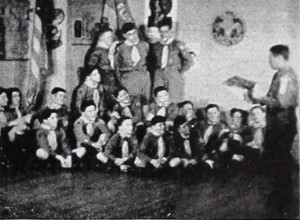
"With its first, full dress training film for Scoutmasters, the Visual Education Service of the Boy Scouts of America embarks, in The Patrol Method, on a new pedagogical path. Instead of presenting the perfect method for emulation, the movie records what happens when Scoutmasters and patrol leaders, with more enthusiasm than shrewdness, do things in ways that invite difficulty. The wiser course is pointed out tactfully, but indirectly, in the film. Here is an unusual employment of the movie medium, but the United States Army and Navy found that it worked in war training. The film is intended for use with a printed outline, and verbal conferences will follow its showings. Directly designed to accomplish a specific teaching task, The Patrol Method does it admirably." Movie Makers, Dec. 1945, 498.
"In Peasants, Konstantin Kostich, ACL, has produced a sympathetic and withal entertaining picture of the people of village and farm land in Czechoslovakia and Roumania. Expert photography, an understanding choice of camera angle and workmanlike sequences mark this interesting film study and serve as a vehicle for its outstanding quality — a sincere and attractive presentation of the people as they are, not as they might be made to appear for the sake of motion picture cleverness. Mr. Kostich needs rely only on his own skill and can afford to neglect making a point of what, in dress or custom, might appear to be a strange peculiarity to another people. Unlike many professional travel photographers, he can avoid these obvious aids to sustain interest and can present his peasants on the friendly basis of real understanding. This does not mean that he does not tell a real story; it simply means that he tells it fairly and sincerely and, hence, beautifully." Movie Makers, Dec. 1934, 534.
"Pets, 350 ft., 16mm., filmed by Dr. F. S. O'Hara, won its position on the list of special mention because of the many remarkably well composed closeups of family pets that it contains and because of the cameraman's patience and skill in securing many delightfully natural bits of action. Included in the film is a sequence of a cat and dog playing together. The film offers much grace and photographic beauty as well as that amazing attractiveness animals always possess on the screen." Movie Makers, Dec. 1931, 686.
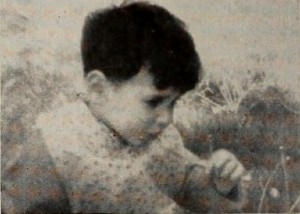
"Irwin Sharpe and Cye Landy have gone back to film beginnings in composing their engaging little etude, Picnic. The fundamental of their selection is the old reliable device of the chase sequence. Beginning quietly with a simple family picnic, the producers soon overlay on this bucolic subject a mysterious kidnapping and its resultant chase. The cutting, camera positions and tempo of this climactic sequence show a true understanding of cinematic expression." Movie Makers, Dec. 1947, 538-539.
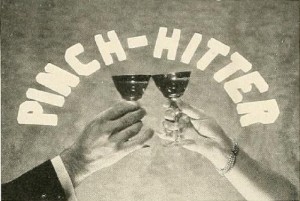
"Pinch Hitter, a photoplay by Charles J. Cafbonaro, has been given Honorable Mention because of its continuously sustained technical brilliance in the face of many problems of cinematic story telling. A suave situation comedy, it presents the dilemma of a girl who is asked once too often by her roommate to substitute for her on a temporarily undesired date. In time, the pinch hitter goes to bat for herself, knocks out a home run and leaves her roommate caught flat footedly out. In presenting this comedy of manners, Mr. Carbonaro has been helped by good acting from his players but hindered by not quite a light enough touch in the film's pace and direction. The lighting and camera work, which are genuinely of top flight quality, go far but not quite far enough in disguising this one weakness." Movie Makers, Dec. 1936, 550.
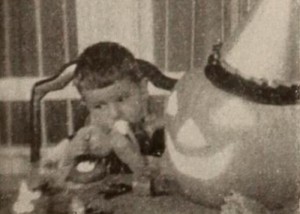
"To those filmers who have had the dubious honor of trying to direct a group of young, obstreperous children who somehow seem to persist in shyly gazing into the camera lens, Harlan M. Webber should be able to give some sound advice. Charming, but not cunning, Pinocchio's Jack-O'-Lantern seems to solve all the usual deficiencies which attend a film starring children. With a sure camera sense, Mr. Webber uses sparkling lighting and imaginative camera viewpoints to bring out the Peter Pan quality which pervades the Halloween party given by his son. The picture opens with startlingly clear shots of the small boy reading a Halloween book and continues with him helping his mother prepare the refreshments for the coming party. In a spirit of understanding and finesse, the filmer follows the antics of the disguised children through the party itself and on to the usual doorbell ringing, where they heinously blackmail the neighbors for candy, cookies and cake. Nostalgically provocative, the film exhibits a buoyant naturalness which would delight any audience." Movie Makers, Dec. 1946, 486.
"Pipe Dreams, by Joseph Dephoure, ACL, and Edward Atkins, ACL, is ranked among the year's ten best because of its considerable triumphs over dramatic and technical difficulties. Through the imagination of its producers, a small cast, simple settings and moderate footage have been used to tell a big story, rich in pictorial effect. Dreaming that he has murdered his unfaithful wife, a young man sees in prospect the swift and fearful course of his life to the waiting gallows. The murder, the trial, the death cell and the hanging are represented in large part only by the imaginative and striking use of shadows of the real scenes. Occasional straight shots are heightened in effect by unusual angles and dramatic lighting. Sensitively planned, smartly executed and deftly cut, Pipe Dreams makes its simple story exciting and forceful." Movie Makers, Dec. 1933, 500.
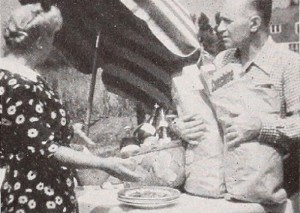
"George Mesaros, who has demonstrated his competence as a maker of good movies in other fields, turns to humor in this film comment on wartime conditions. The point of the story — for it is the foray and not the tale that is pointless — turns on providing for a picnic in the yard of the home. While the master of the house is shopping with ration points, the skeptical family gets, from the Victory garden, cooks and eats the alfresco feast, at the end of which Father — who really did find something in the shops — returns with loaded arms. First class Kodachrome pictures and a well knit continuity are used by Mr. Mesaros to bring to American audiences something of the spirit of easy and natural outdoor fun with food that for so long characterized the Europe of happy memory. Some of the scenes of cooking are so realistic that one almost reaches for what is shown on the screen." Movie Makers, Dec. 1943, 478.
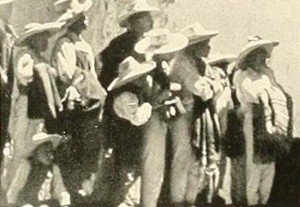
"One comes from a screening of Primitive Patzcuaro, by Ralph E. Gray, with an overwhelming impression of pure beauty. Here, in compositions which often echo the Old Masters in their warmth of color and satisfying balance, an amateur movie maker has turned his camera on the simple life about him and found it pleasing. One after another, the magnificent scenes and sequences bring from the spectator that involuntary expression of deep pleasure which is ambrosia even to the great of amateur movies. In Primitive Patzcuaro, Mr. Gray has portrayed, with leisure, the life of the Tarascan Indians, remote from civilization in a rarely visited section of Mexico. Although magnificent in its color studies, the film is abundant in human interest as well; in portions devoted to the bright native dances and religious ceremonies, it presents a series of tableaux that are breath taking in their effectiveness." Movie Makers, Dec. 1937, 626-627.
"Cheering crowds greet the Prince of Wales - later to be the uncrowned Edward VIII - as his car passes by. The crowds also turn out for the third World Scout Jamboree at Arrowe Park on the Wirral. With tens of thousands of scouts attending, the event commemorated the 21st birthday of the Scouting Movement and the publication of 'Scouting for Boys', so it became known as the Coming of Age Jamboree." (BFI Player)
Total Pages: 29